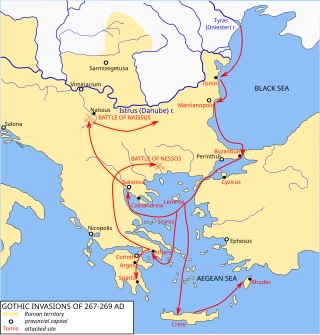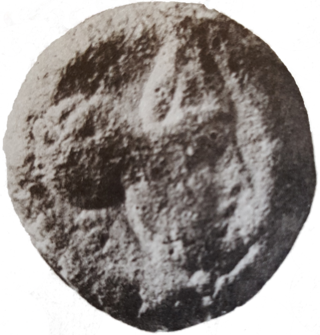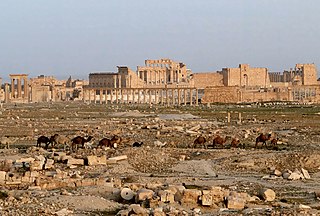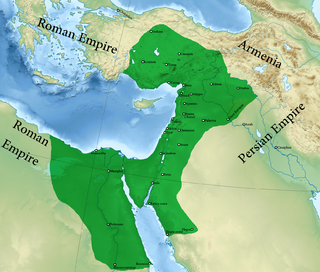
Septimia Zenobia was a third-century queen of the Palmyrene Empire in Syria. Many legends surround her ancestry; she was probably not a commoner and she married the ruler of the city, Odaenathus. Her husband became king in 260, elevating Palmyra to supreme power in the Near East by defeating the Sasanian Empire of Persia and stabilizing the Roman East. After Odaenathus' assassination, Zenobia became the regent of her son Vaballathus and held de facto power throughout his reign.

Year 267 (CCLXVII) was a common year starting on Tuesday of the Julian calendar. At the time, it was known in Rome as the Year of the Consulship of Paternus and Arcesilaus. The denomination 267 for this year has been used since the early medieval period, when the Anno Domini calendar era became the prevalent method in Europe for naming years.

Legio III Cyrenaica, was a legion of the Imperial Roman army. The legion had its origins among the forces of Mark Antony during the civil wars of late first century BC. In the Imperial period it was stationed in Egypt, where it played a key role in campaigns against the Nubians and Jews. In the first century AD, it was usually located in Arabia Petraea. There are still records of the legion in Syria at the beginning of the 5th century. The legion symbol is unknown.

Arabia Petraea or Petrea, also known as Rome's Arabian Province or simply Arabia, was a frontier province of the Roman Empire beginning in the 2nd century. It consisted of the former Nabataean Kingdom in the southern Levant, the Sinai Peninsula, and the northwestern Arabian Peninsula. Its capital was Petra. It was bordered on the north by Syria, on the west by Judaea and Egypt, and on the south and east by the rest of Arabia, known as Arabia Deserta and Arabia Felix.

Septimius Odaenathus was the founder king (Mlk) of the Palmyrene Kingdom who ruled from Palmyra, Syria. He elevated the status of his kingdom from a regional center subordinate to Rome into a formidable state in the Near East. Odaenathus was born into an aristocratic Palmyrene family that had received Roman citizenship in the 190s under the Severan dynasty. He was the son of Hairan, the descendant of Nasor. The circumstances surrounding his rise are ambiguous; he became the lord (ras) of the city, a position created for him, as early as the 240s and by 258, he was styled a consularis, indicating a high status in the Roman Empire.

Septimius Vaballathus was emperor of the Palmyrene Empire centred at Palmyra in the region of Syria. He came to power as a child under his regent mother Zenobia, who led a revolt against the Roman Empire and formed the independent Palmyrene Empire.

The Battle of Emesa was fought in 272 between the Roman armies led by their emperor Aurelian and the Palmyrene forces led by their empress, Zenobia and general Zabdas.

The Battle of Immae was fought in 272 between the Roman army of Emperor Aurelian, and the armies of the Palmyrene Empire, whose leader, Empress Zenobia, had usurped Roman control over the eastern provinces.

The Palmyrene Empire was a short-lived breakaway state from the Roman Empire resulting from the Crisis of the Third Century. Named after its capital city, Palmyra, it encompassed the Roman provinces of Syria Palaestina, Arabia Petraea, and Egypt, as well as large parts of Asia Minor.

Zabdas was a 3rd-century Syrian general who led the forces of Empress Zenobia of Palmyra during her rule as regent of her son Vaballathus and her subsequent rebellion against the Roman Emperor under the short-lived independent Palmyrene Empire. He led Palmyra's expeditions in the middle east which included annexing territory spanning from Roman Egypt to Asia Minor.

The Tanûkhids, Tanukh, or Banū Tanūkh were a confederation of Arab tribes, sometimes characterized as Saracens. They first rose to prominence in northern Arabia and southern Syria in the 2nd century CE. Both Lakhmid and Tanukhid inscriptions have been found at Umm el-Jimal in Jordan and Namara in Syria. The ancient Tanukh tribal confederation was largely taken over by several branches of the large Azd and Quda'a tribes. Their main base during the time of their most famous ruler, Queen Mavia, was in Aleppo. During the 8th and 9th centuries, the Tanukhid strongholds were the cities of Qinnasrin and Maarat al-Numan.
Callinicus, surnamed or nicknamed Sutorius or Suetorius, sometimes known as Kallinikos of Petra or Callinicus of Petra was an ancient Greek historian of Arab descent, orator, rhetorician and sophist who flourished in the 3rd century.
The Roman presence in the Arabian Peninsula had its foundations in the expansion of the empire under Augustus, and continued until the Arab conquests of Eastern Roman territory from the 630s onward.
The Siege of Tyana occurred in 272 CE. The forces of the Roman Emperor Aurelian were seeking to conquer the Palmyrene Empire.

Palmyra is an ancient city in the eastern part of the Levant, now in the center of modern Syria. Archaeological finds date back to the Neolithic period, and documents first mention the city in the early second millennium BC. Palmyra changed hands on a number of occasions between different empires before becoming a subject of the Roman Empire in the first century AD.

Septimius Herodianus or Hairan I was a son and co-king of Odaenathus of Palmyra. Through his father's marriage to Zenobia, Hairan I had two half-brothers, Hairan II and Vaballathus.
Septimius Haddudan was a 3rd-century Palmyrene official, the only known Palmyrene senator other than Odaenathus, and a priest and symposiarch of the god Bel, who is known to have opposed the rule of Queen Zenobia of Palmyra and aided the Roman Empire during their wars against the queen.

The Palmyrene invasion of Egypt occurred in the summer, or possibly in October, of 270 AD when the forces of Queen Zenobia of Palmyra, led by her general Zabdas and aided by an Egyptian general named Timagenes, invaded and subsequently annexed Egypt, which was under control of the Roman Empire at the time.
The Legio I Illyricorum was a Roman Legion stationed in Qasr el-Azraq and Palmyra; it is mentioned in the Notitia Dignitatum. According to many ancient sources, it was stationed within the Eastern Half of the Roman Empire, under emperor Aurelian.
Timolaus of Palmyra was reportedly a 3rd century Palmyrene nobleman, son of the king of kings Odaenathus and augustus Zenobia. Little is known about him, and all the existing information comes from speculation. Such is the doubt of his existence that some scholars try to associate him with Vaballathus, another of the sons of Odaenathus and Zenobia. Some authors believe he is an individual made up by the Historia Augusta, the only historical source that cites him, and some speculate that he is in fact a historical figure. He appears only in 267, at the time of his father's assassination.














